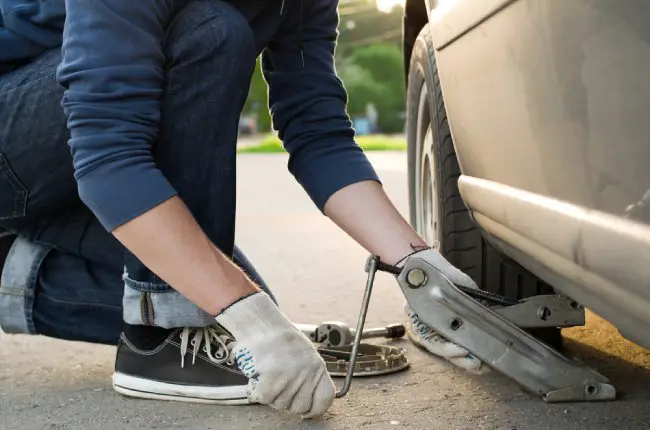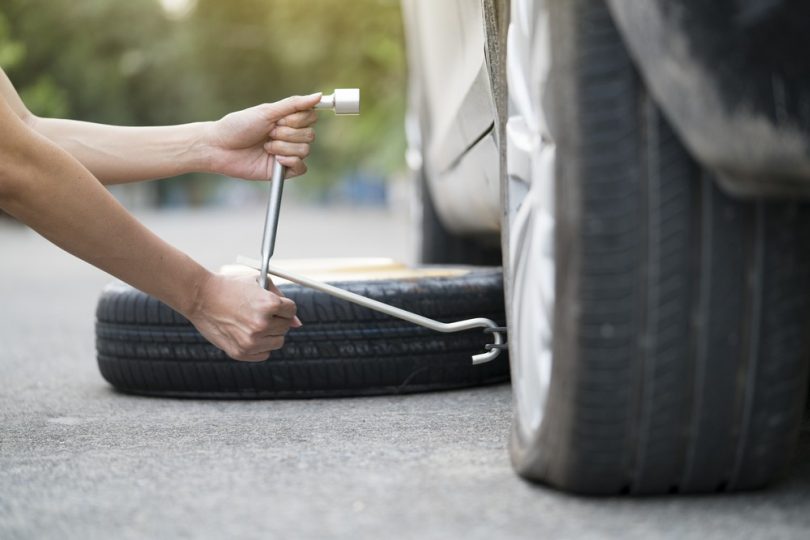It’s hard to find someone who hasn’t experienced a flat tire at some point in their life. You really need to know how to change your tire quickly and safely in case one of your tires goes flat.
We’re here to guide you with pro tips!
How to Fix a Flat Tire on a Car?
Tools you’ll need
- Tire-repair kit
The first thing you’ll need is a tire repair kit. Make sure it includes rope plugs, needle-nose pliers, a cutter, insertion needle, valve cores, and other tools you’ll need.
- Air compressor
You also need a compressor to reinflate the tire after the puncture is fixed. Get a backup compressor that plugs into a 12-volt outlet or a cigarette lighter so you don’t have to open the hood.
But get a full-fledged air compressor in case you often pump up larger cross-country tires.
- Flat tire sealants
A can of good quality sealant is a must-have for your car. Get a sealant with compressed air that’ll allow you to deal with small pinhole leaks caused by a nail or screw without having to remove the wheel.
It will also come in handy for complex repairs or when you have to roll the car for an extra few hundred yards to get to the workshop.
- Tire-pressure gauge
Use a tire-pressure gauge and adjust the pressure of your tires according to the factory-suggested settings in case they’re off. A good rule of thumb is to use it at least once a month.
Ambient temperatures, just time, or elevation can cause the tire to drop or increase pressure and harm the vehicle’s performance, handling, or fuel economy.
Easy Flat Tire Fix: Step by Step

1. Discover the puncture
Find a safe spot to pull over and see which tire is flat. Locate the source of the puncture.
Sometimes the object will be clear at the first glance and sometimes you’ll have to roll the vehicle a foot or two to uncover the issue.
Nail or screw?
If a nail or screw is deeply stuck in the tire’s tread, you may choose to remove the object when you get to the workshop. For now, use a can of sealant containing compressed air as a temporary fix.
Simply connect the sealant to the valve and empty the entire can into your tire. Soon you will see the tire has inflated a bit. Now wait for some time and let it get back to its normal condition.
As soon as you notice that, drive off immediately. Pull the brakes and come out to check if the pressure is okay in case you have doubt. Make adjustments if necessary.
You’re only good to continue if the tire is holding up perfectly. Don’t forget to have a good look at it each time you stop.
When done driving, follow the rest of the steps below to fix the puncture with a plug.
2. Remove the affected wheel
Start by removing your spare and placing it underneath the frame of your car; behind the rear tire or in front of the front tire. This will protect you and your vehicle in case it falls off the jack.
Relax the lug nuts before you elevate the car. Locate the jack and use it in accordance with the instructions in the owner’s manual.
Once the wheel is off the surface, take out the lug nuts and keep them in a safe place. Be careful when you pull the wheel outwardly.
3. Examine the puncture
A hole in the tread can be fixed, but you need to mount the spare and have the old one replaced when the pit is in the sidewall – the rough vertical part of the tire.
In case the object is in the tread of the tire and can’t be dealt with by pushing a can of sealant, look for the broken spot as you roll ii and listen carefully. If there’s no hissing sound and air leaks, mark the trench so you can easily find it later.
4. Extract the piece
Take out the external object in the tire if your tire can no longer hold air. You can use needle-nose pliers and easily pull it out.
The object could be a steel bar, a nail, a sharp stone, or a cactus barb. Organic bits and pieces can leave remains behind. Be sure to get all of that out of your way.
5. Extend the hole
Grab your tire repair kit and enlarge the hole with a reamer. Be careful while you push the reamer, it shouldn’t go too deep.
Now slowly put pressure and screw down into the tread. You may take a look at what you need to insert and make the hole accordingly.
Extend until it gets to the extent of a pencil. Pass the step if the hole is already larger than a pencil.
6. Install the Plug
It can be extremely tricky to get a plug through the tire hole because they’re meant to be hard to confiscate and it won’t be easy to insert into the eyelet, but your pliers will come in handy.
Unwrap a rope plug and even out one end using your needle-nose pliers and get it through the eyelet on the tip of the installation reamer.
Make sure the rope plug is equal on both sides of the eyelet since you need to get two layers of plugs through the hole you made. Apply a finger of lube to the plug for a smoother push into the tire.
Hold the installation tool with both hands and firmly put its tip down into the hole of the tire until the depth indicator becomes level with the tread. …. Yank the installation tool out of that hole as hard and fast as you can.
The rope plug needs to traverse the eyelet and remain inside to seal off the tire. Don’t forget to try another if you cannot pull the first one off at once. Trim the access of the plug to finish it.
Note: One plug should be enough for a moderate puncture. Sometimes you may need multiple plugs for a thicker hole. In a situation when you need to install more than one plug, It’s a good idea to take your car to a seasoned mechanic’s shop.
7. Reinstall the Wheel
Inflate your tire to the recommended number using an air compressor. If it holds up to the recommended pressure, reverse the tire removal process and you’ll be good to go.
Make sure you check the pressure a few more times in 24 hours. Apply some sealant if you’re still losing a little bit of air.
FAQs
1. How much does it cost to fix a flat car tire?
Ans: A standard flat car tire will typically cost you between $5 and $40 to fix in a repair shop. And $30-$60 while repairing a run-flat tire.
2. How do you know you’ve got a puncture?
Ans: Your steering wheel starts wobbling in your hands imprecisely or you hear a brash thumping noise happening together with the wheel’s turning, and suddenly you’ve got a flat tire. The thumping reaches you even before you could feel it with the steering wheel while driving off-road at a lower speed.
3. Is it better to patch or plug a tire?
Ans: Patches are better when the hole is bigger and not closer to the sidewall, and unconventional. A plug will work better with completely straight and smaller holes.
4. How long can you drive with a tire plug?
Ans: Although it’s hard to determine, a well-installed tire plug should last the entire life of the tire – up to 10,000 miles. On average, you can drive 5,000 t0 10,000 miles with a plug inside your tire. It will depend on the type of flat tire you had and how well the plug was installed.










Leave a Comment